Gus Nweke
Visualising the Unseen
Igbo belief system sees existence as a dynamic interplay between the material and immaterial, the physical and the spiritual world. In Igbo cosmology, the Shadow is a metaphorical representation of the unseen and used in storytelling, proverbs, and folklore. Uli is an indigenous Igbo artistic tradition mainly used in body and wall painting. It encapsulates profound philosophical and spiritual meanings through abstract, curvilinear forms and shapes, including ideas related to temporality, transformation, and metaphysical existence. The Project concerns the Shadow, and it aligns with the worldview of my native origin, which is rooted in duality in existence. The study will explore the theme further with the uli art form because it is the art of the Igbos.
Initial Draft Idea

The Shadow image from desert video

note from Antony Gromley’s interview with Iwona Blazwick 09/10/19
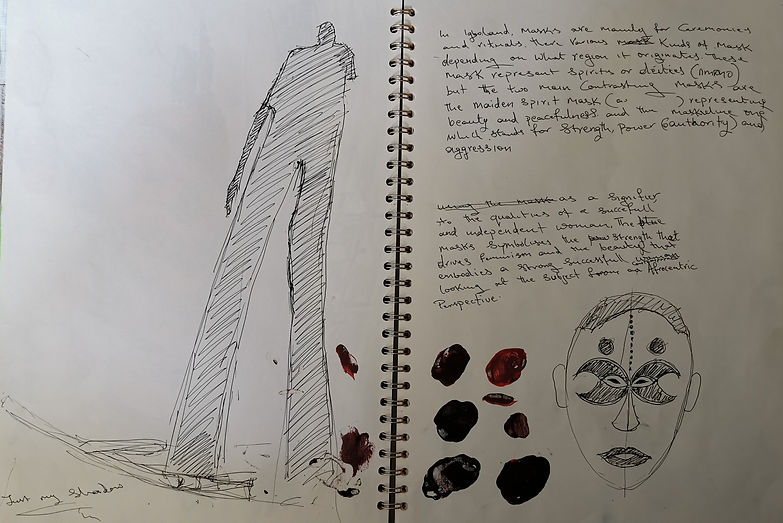
Introduction
As a child, I loved to chase the Shadow because my Dad taught me that it is a pointer to a presence. Some years later, I had an epiphany which led to a critical encounter with the Shadow in the Desert in 2019. Since then, I have observed the shadow appearances on various surfaces within different timelines, under multiple conditions and projections, to understand its characteristics and evaluate its usability as a theme for a painting project. As I continued with the enquiry, I came across Iwona Blazwick’s interview with Antony Gromley, in which he stated that ‘the body should be treated like a space’. My initial concern was finding a meaningful way to respond to the Shadow sensibly. However, to a certain extent, Gromley’s assertion aligns with the uli’s visual expression of lines and the curves navigating the space, the dark shaded areas that are sensible to the environment and a projected image that conforms to such sensibility. Since the Shadow is a space on its own, the next question was, what do I do with the space? I wanted my Painting of the shadow image to have a symbolic relationship with the subject. Therefore, I interrogate the Shadow from my ethno-aesthetic experience by introducing the Igbo cultural and artistic elements. I meet Krydz Ikwuemese, a professor and head of art school at the University of Nigeria Nsukka, through a friend. He has extensively researched uli and spearheaded the preservation of uli art for over two decades. He lectured me on the historical context of uli as an ancient Igbo art, then invited me to an exhibition, Forward to the Past, in Brunei Gallery, SOAS London, in 2022. The Exhibition future the works of UNN Alumni who have championed uli revival for decades. Further research led me to Re Entanglements by Paul Basu. The Exhibition sought to re-engage with Colonial Archives in the Decolonial Time.
The documents and images from this Exhibition were mostly from Northcott W Thomas’s anthropological report of the Ibo-speaking people of Nigeria. However, Paul Basu’s work seeks to connect the archives with the descendants of those images. In contrast, I thought about the moments that got cut out of the archives due to the imperialist operation of the camera, which Ariella Azoulay referred to as the ‘shutter moment’. She posited that ‘it commands what sorts of things have to distanced, bracketed, removed, forgotten, suppressed, ignored, overcome and made irrelevant’. At that point, I decided to use the shadow images to index the images cut out by the archive. Most importantly, it will unfreeze uli from primitivism to modernity by adopting the shadow image as the physical representation of the metaphysical.
The research aims to create a rich dialogue between traditional Igbo beliefs and contemporary art practices, contributing to broader discourses on presence, absence, and duality in existence. It is a beautiful fusion of cultural heritage, artistic innovation, and philosophical inquiry.
Materials and Experiment
My initial materials for this Project were plaster, cement, and metal ring. I want to create an illusion of depth because that defines Shadow. I hoped to cut out the shadow form, making it visible from both sides, and the walls decorated with inscriptions. By making the Shadow the subject, I hope it will invite the viewers to see beyond the moment captured and held in the archives and follow the lead of its Shadow to unfreeze the Past by re-imagining it.
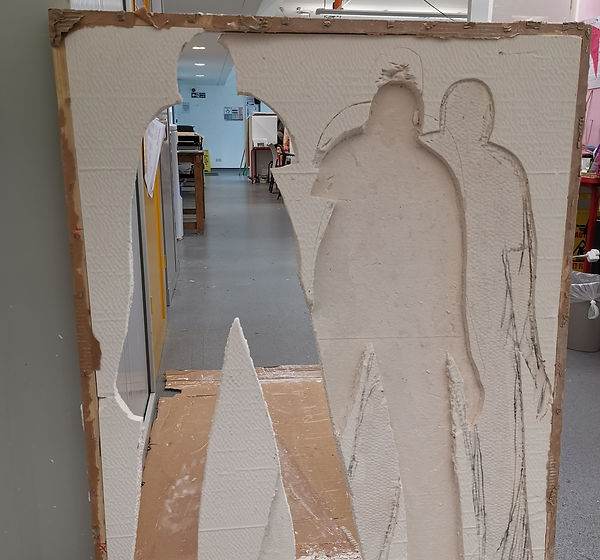
Plaster cut on frame
This experiment failed to be completed because the studio space was small, and the material was heavy, bulky, expensive and not readily accessible. Although it would have addressed the durability issue, I needed more flexible material that relate to my practice.
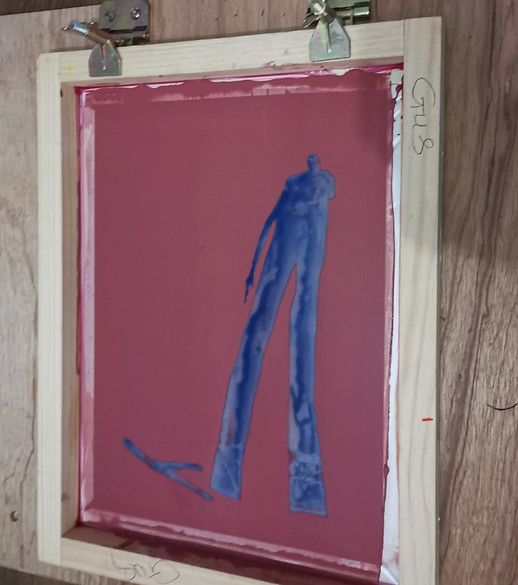
Stencil Blocker techniques
The first experiment did not produce the required result, so I switched to a more manageable material. Although I had induction training on silkscreen studio equipment, I used the mesh blocker technique for the stencil after an online tutorial. I liked the idea of screen print. It feels like impressing a presence; you never know how it will turn out. The outcome becomes elusive like the Shadow is.

My Desert Shadow 2020. Acrylic Print on Paper 43cm x 58cm
The final Print of the first experiment came out fine; it projected the shadow image from the sketch, but I was not satisfied with the outcome. One feedback states, ‘nice print but no context’. Another said, ‘Desert shadow ya, but how does that connect to you?’ These two critical feedback pieces made me rethink what narrative to pursue and what context to use. Based on my native Igbo worldview, I explored the subject further along the lines of postcolonial culture, identity and my ethno-aesthetic experience as a global diaspora.

The Unseen Images
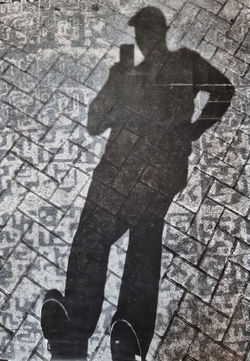 still experimenting on the idea of texture and surface. I was hoping to project the shadow on that surface without losing details and elemts of the designs. |  |  |
|---|---|---|
 The Kuba clothes inspired pattern. represents a good example of how a local African design influences a global visual culture similar to Paul Klee's Comedian Handbill. |  to achieve the effect of beaten and ruined, i have to paint on screen printed surface multiple time |  Onyinyo 1, 2021. Acrylic Print on Painted Canvas. 180cm x 160cm. Final work from my experimentations. |
 Black shadow. 2021 130cm X 100cm Screen print on painted canvas |  Digital image (Pareidolia) |  Screen Print on Paper |
|---|---|---|
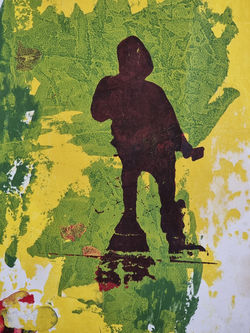 Shadow Test Print. 2021 Screen Print on Paper |  Blue shadow. 2021 130cm X 100cm Screen print on painted canvas |  Orange shadow. 2021 130cm X 100cm Screen print on painted canvas |